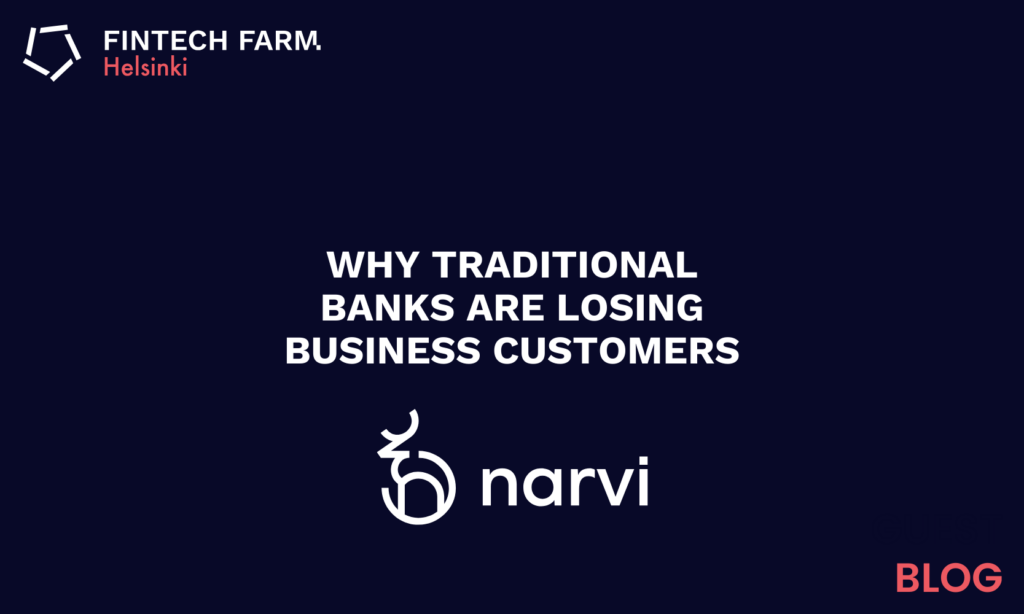The rise of digital banking marks a bold new era in the Finnish financial landscape. While legacy banks are stuck in the past, agile neo-banking services are ahead of the curve, catering to the needs of Finnish businesses.
But does this financial shift help or hinder our economy? Why are legacy banks becoming even more risk-averse? And should we all switch to digital banking? In this article, I’ll dive into these questions and explore what digital banking means for businesses across Finland.
Why Are Traditional Banks Losing Customers In Finland?
A big reason why traditional (or legacy) banks in Finland are losing customers is actually by their own design. Legacy banks are becoming more risk-averse, so many businesses are being denied access to banking services altogether. This is what a survey by the Finnish Accounting Union has found.
Opening a business bank account in Finland has always been challenging, especially for companies based outside the country. But now, the criteria are even stricter, and many more businesses are being categorized as “high-risk” by these legacy banks.
If your business, for example, has international offices, is a start-up or SME, is in a “high-risk” industry, or lacks banking history, such as balance sheets, you might now find it tricky or even impossible to open an account with a legacy bank.
Unsurprisingly, these “high-risk” businesses now turn to neo-banks, which are just as secure but are more willing to work with businesses that fall outside the legacy banks’ narrow criteria. Plus, these digital neo-banks often have much faster onboarding processes and a more transparent banking service, amongst other things (more on this later).
Why Are Legacy Banks Becoming More Risk-Averse?
In short, legacy banks are becoming more risk-adverse because they can be. Globally, banks have been making record profits, including Nordea and Danske Bank. So why not be picky with your clientele if it leads to more security and fewer headaches?
On the other hand, this cautious approach hasn’t appeared out of nowhere. Several legacy banks across the Nordics have come under scrutiny for failing to meet compliance standards, which, in turn, has led to money laundering scandals and heavy fines. Since then, these banks have been treading much more carefully by tightening their onboarding criteria and focusing on businesses that promise maximum profitability.
Legacy Banks Vs. Digital Banks In Finland
By now you might be wondering: is it worth making the switch to a digital neo-bank? Well, it really depends on your business. If you want to take out loans (and are in a good position to do so) or are in general happy with your banking service, then I see no urgent reason to switch to another type of bank.
However, if your business falls into a legacy bank’s “high-risk” categorization, then you may want to (or may have to) turn to a neo-bank.
Digital neo-banks are often designed to support companies with needs that traditional banks can’t (or won’t) accommodate. They tend to specialise in onboarding SMEs, startups, and businesses with international operations. They are just as compliant and regulated as legacy banks, but they’re generally more reliable when it comes to keeping your account open.
Even if your company isn’t classified as “high-risk”, you could still benefit from the other advantages digital neo-banks offer, such as:
Faster Onboarding
Legacy banks have slow and complicated onboarding processes, often taking weeks or months and involve manual steps like phone calls and in-person interviews. In contrast, due to being fully digital, neo-banks offer onboarding processes that can take just 10-15 minutes – an important bonus for start-ups where time is of the essence.
International Payments
Many neo-banks specialize in international payments, offering much lower transfer fees and simpler pricing structures than legacy banks, which are not made to be as agile. For businesses that send or receive payments internationally, especially outside the SEPA area, making the switch is a no-brainer.
Transparent Banking
Thanks to their digitization, neo-banks provide you with clear and transparent cost structures and easy access to your banking history. Their use of APIs allows you to view all your banking information in real time.
Newer Tech
Neo-banks have the advantage of building compliant systems from the ground up, so are more innovative and adaptable. In contrast, legacy banks often rely on outdated systems that struggle to keep up with current banking needs.
Are There Risks To Digital Banking?
Your money is just as safe in a digital neo-bank – or even safer! Neo-banks are fully regulated by the same authorities that oversee legacy banks (for example, Finnish FSA) and store your funds with reputable, compliant banking partners.
Digital neo-banks with in-house built technology can oftentimes be more secure than legacy banks. Neo-banks like Narvi are better equipped to handle cyberattacks since they don’t rely on external services. Plus, they offer advanced security features, such as two-factor authentication, passkeys, and hardware wallets, to keep your account safe.
Will Modern Banking Positively Affect The Future Of Finnish Business?
The risk aversion of legacy banks is sadly hurting Finland’s start-up and international business culture – and the problem is only going to get worse due to rising compliance costs, a lack of action from the Finnish government, and the reluctance of Finnish legacy banks to collaborate with neo-banks to find a solution.
While this is a problem across Europe and even globally, some countries are actively working to help “high-risk” businesses open bank accounts. Take Estonia, for example: their e-residency program, backed by the government, helps internationals secure Estonian bank accounts by partnering with digital neo-banks. With this program, Estonia has boosted economic growth and fostered diverse businesses and ideas.
While there isn’t a government-supported scheme like this in Finland, thanks to neo-banks such as Narvi, international businesses, start-ups, and SMEs can thrive and maintain Finland’s status as a hub for entrepreneurship and global business.
Digital Banking And The Future
Digital neo-banks such as Narvi Payments are transforming the banking landscape in Finland by supporting international payments, providing bank accounts for start-ups and SMEs, and paving the way for transparent, accessible, and secure banking with their agile technology.
These neo-banks are challenging traditional banking models by offering clients more choices and catering to the ever-evolving needs of Finnish businesses.

Toni Kivinen, Head of Nordic Markets at Narvi Payments Oy Ab


